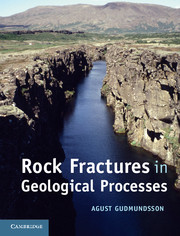Book contents
- Frontmatter
- Contents
- Preface
- Acknowledgements
- 1 Introduction
- 2 Stress
- 3 Displacement and strain
- 4 Relation between stress and strain
- 5 Loading of brittle rocks to failure
- 6 Stress concentration
- 7 Theories of brittle failure of rocks
- 8 Extension fractures and shear fractures
- 9 Displacements and driving stresses of fractures
- 10 Toughness and fracture mechanics
- 11 Field analysis of extension fractures
- 12 Field analysis of faults
- 13 Evolution of extension fractures
- 14 Evolution of faults
- 15 Fluid transport in rocks – the basics
- 16 Fluid transport in faults
- 17 Fluid transport in hydrofractures
- Appendix A Units, dimensions, and prefixes
- Appendix B The Greek alphabet
- Appendix C Some mathematical and physical constants
- Appendix D Elastic constants
- Appendix E Properties of some crustal materials
- Index
- References
17 - Fluid transport in hydrofractures
Published online by Cambridge University Press: 05 June 2012
- Frontmatter
- Contents
- Preface
- Acknowledgements
- 1 Introduction
- 2 Stress
- 3 Displacement and strain
- 4 Relation between stress and strain
- 5 Loading of brittle rocks to failure
- 6 Stress concentration
- 7 Theories of brittle failure of rocks
- 8 Extension fractures and shear fractures
- 9 Displacements and driving stresses of fractures
- 10 Toughness and fracture mechanics
- 11 Field analysis of extension fractures
- 12 Field analysis of faults
- 13 Evolution of extension fractures
- 14 Evolution of faults
- 15 Fluid transport in rocks – the basics
- 16 Fluid transport in faults
- 17 Fluid transport in hydrofractures
- Appendix A Units, dimensions, and prefixes
- Appendix B The Greek alphabet
- Appendix C Some mathematical and physical constants
- Appendix D Elastic constants
- Appendix E Properties of some crustal materials
- Index
- References
Summary
Aims
How hydrofractures transport crustal fluids is important in many fields of earth sciences, including petroleum geology, geothermal research, volcanology, seismology, and hydro-geology. In the previous chapters the focus has been on the transport of ground water, geothermal water, and gas and oil. Here the main examples come from two fields: man-made hydraulic fractures, as are used to increase the permeability of reservoirs (petroleum and geothermal); and volcanology, that is, the transport of magma through vertical (dykes), inclined (sheets), and horizontal (sills) intrusions. It should be stressed, however, that the basic principles of fluid transport in hydrofractures are the same irrespective of the type of fluid. Thus, the results obtained here apply equally well, with suitable modifications, to hydrofracture transport of ground water, oil, and gas. The principal aims of this chapter are to explain and discuss:
The source of the driving pressure (overpressure) in hydrofractures, including the effects of buoyancy.
The initiation, propagation, and fluid transport in man-made (artificial) hydraulic fractures.
Fluid transport in magma-driven fractures, primarily dykes and inclined sheets.
Fluid transport in fractures driven by hydrothermal fluids, that is, fractures that subsequently become mineral veins.
- Type
- Chapter
- Information
- Rock Fractures in Geological Processes , pp. 525 - 556Publisher: Cambridge University PressPrint publication year: 2011
References
- 1
- Cited by



